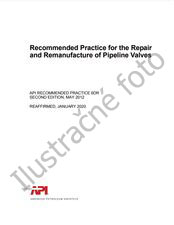Potrebujeme váš súhlas na využitie jednotlivých dát, aby sa vám okrem iného mohli ukazovať informácie týkajúce sa vašich záujmov. Súhlas udelíte kliknutím na tlačidlo „OK“.

API RP 2207-ed.8
Preparing Tank Bottoms for Hot Work
NORMA vydaná dňa 1.4.2022
Informácie o norme:
Označenie normy: API RP 2207-ed.8
Dátum vydania normy: 1.4.2022
Kód tovaru: NS-1140074
Počet strán: 28
Približná hmotnosť: 84 g (0.19 libier)
Krajina: Americká technická norma
Kategória: Technické normy API
Anotácia textu normy API RP 2207-ed.8 :
API RP 2207, 8th Edition, April 2022 - Preparing Tank Bottoms for Hot Work
This RP addresses only the safety aspects of hot work performed on petroleum storage tank bottoms. It discusses safety precautions for preventing fires, explosions, and associated injuries. The term “hot work,” as used in this publication, is defined as an operation that can produce a spark or flame hot enough to ignite flammable vapors. API Recommended Practice 2009 provides more in-depth information on safe hot work practices, and its requirements are not duplicated here.
This RP does not contain all safety precautions and procedures that may be required prior to, during, or after a specific hot work activity. All hot work should be performed in compliance with applicable federal, state, and local regulatory requirements and recognized industry practices. Work practices of concern for working on tank bottoms include, but are not limited to, confined space entry, lockout/tagout, atmospheric testing, ventilation, and requirements for use of personal protective equipment (PPE). API Standard 2015 provides guidance for tank entry consistent with OSHA regulations noted in Section 2, Normative References. This RP does not repeat the detailed information provided in the referenced documents. Some of the relevant OSHA regulations from 29 CFR Part 1910 and 29 CFR Part 1926 are included in the references. It is the responsibility of each organization to review and comply with applicable regulatory requirements.
This RP does not cover the following:
- — guidance for compliance with safety or environmental regulations or codes;
- — engineering specifications for tank construction or rebuilding (see API tank standards);
- — specific guidance for repair of shop-fabricated tanks, which is addressed by STI/SPFA SP031. These tanks include those built to UL 142, API 650, STI/SPFA aboveground tank standards, as well as others;
- — specific guidance for tank entry (see API 2015);
- — welding techniques, craft skills, or qualification of welders (see referenced welding standards);
- — normal “safe work” practices such as fall protection, PPE, slip/trip/fall, etc.;
- — entry or work in inert environments (see API 2217A);
- — entry into confined spaces for construction activities (see OSHA 29 CFR Part 1926, Subpart AA, and Part 1926.1200).
Hazards have the inherent ability to cause harm. Flammability, toxicity, corrosivity, and stored chemical or mechanical energy all are hazards associated with various industrial materials or situations. Risk requires exposure. A fire or hot surface can cause thermal skin burns or a corrosive acid can cause chemical skin burns, but these can occur only if there is contact exposure to skin. In an empty tank, a floating roof represents a “stored mechanical energy” hazard that might fall on persons working underneath, and so must be properly secured to reduce the risk of contact before performing entry work. Risk is created when hazards have a potential for exposure.
Determining the level of risk involves understanding hazards and estimating the probability of exposure and severity of consequences that could lead to harm. While the preceding examples relate hazards to the risk to people, the same principles are valid for evaluating property and environmental risk. For instance, a flammable mixture of hydrocarbon vapors in air can ignite if exposed to a source of ignition, resulting in a fire that could damage property, as well as injure people.
This RP aims to share practices, which over time have been useful in injury prevention programs. The specifics of compliance with either safety, environmental laws, or regulations are outside the scope of this RP but should be carefully reviewed by those authorizing and conducting work.
Odporúčame:
Aktualizácia technických noriem
Chcete mať istotu, že používate len platné technické normy?
Ponúkame Vám riešenie, ktoré Vám zaistí mesačný prehľad o aktuálnosti noriem, ktoré používate.
Chcete vedieť viac informácií ? Pozrite sa na túto stránku.



 Cookies
Cookies
